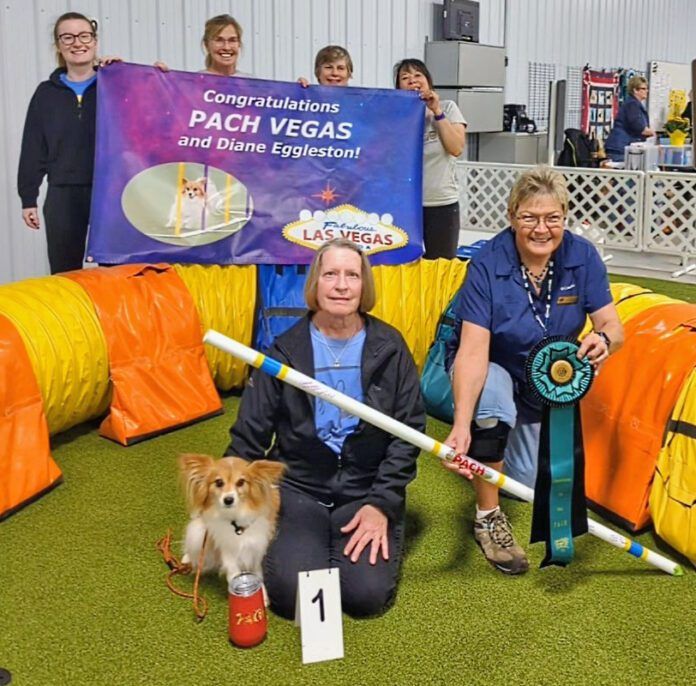Dog agility is as fun as it looks! It’s easy to get started in dog agility. The only agility equipment you need to start is a low jump or two, which you can make yourself by setting a PVC bar on top of two short buckets or cinder blocks. Add in lots of praise and high-value treats, and you’re on your way. For more on the sport of agility, see sidebar, below.
If you and your dog find this intro fun, you’ll soon want to invest in some real agility equipment. “The most basic equipment I would recommend would be at least four jumps and 12 weave poles,” says Diane Eggleston, an experienced agility instructor and highly successful competitor (see video of Eggleston running her Papillon dog Vegas). Eggleston ran her Awesome Abilities Agility training school for 15 years. She now teaches a few classes a week at the Syracuse (N.Y.) Obedience Training Club.
A set of 12 weave poles costs between $375 and $600. A jump with wings is around $200. Without wings, a jump is $125. Be careful not to purchase inferior flimsy equipment. Look for competition equipment, which is made to the requirements of the different dog agility organizations, like the American Kennel Club, Canine Performance Events, the U.S. Dog Agility Association, and more.
As your interest grows, so will your desire to add equipment, such as a tunnel. For most competitors, having access to the more difficult (and more expensive) obstacles at a training facility is enough.
Fitness Matters
Agility is physically hard on dogs, which means the dog needs proper training and conditioning. “A dog should have good structure and be physically able to do all the running and jumping involved with agility. This is not a sport for overweight dogs,” says Eggleston. “If the dog passes the physical criteria, the other important thing to consider is whether the dog having fun. Some dogs do not enjoy the sport. I hate to see dogs running slow and pokey because they are only doing it because they love their owner,” says Eggleston.
Starting your training in an agility foundation classes with an experienced trainer is money well spent. Getting the right start is critical. The agility trainer can evaluate your dog and help you determine the best approach to get him fit and keep him happy. He or she will also train you, so you can cue the dog properly. If you don’t ask the dog to do something correctly, he won’t know what you want. “When training your dog at home or anywhere else never blame the dog for the handler’s errors,” says Eggleston.
Dog Agility Benefits
Agility is an addictive team sport. For most of us, it’s the challenge of training your dog, seeing his excitement, and spending time with people who share a common interest. Agility builds a dog’s mind, body, and soul, and enhances your bond with your dog. But you do need to train with the right attitude. Remember that agility is not about winning, although that is certainly fun. Agility is about spending time with your best friend doing something you both enjoy.
Dog agility is a timed event with obstacles the dog races through or over. Speed and accuracy are important to your success. The run is always off leash, and handlers communicate with the dog using verbal cues and body language, motion, and positioning.
No rules dictate what cues you use for your individual dog, and many handlers have their own set of words for various obstacles, turns, and speed. But there are commonly used terms, like break, left, right, check, dig, wait, and more. You’ll train verbal and body cues that tell your dog to turn right or left, make a tight turn (called a wrap), take an obstacle from the opposite/back side, slow down, move ahead quickly (go!), and more.
Most dogs quickly learn the names of the obstacles: jump, tire, tunnel, table, A-frame, and dog walk (walk it!), and you’ll hear many handlers repeat the term three times as the dog approaches the obstacle. As the dog becomes more confident in your communication, his speed naturally increases. That is one of the many reasons why agility handlers say, “The dog is never wrong.”
A dog should have foundation handling skills before starting agility, knowing how to walk quietly on leash, stay when cued, and has a strong recall (return to you when called). He doesn’t need to be an obedience dog, but he does need the basics.
Classes are divided by the dog’s height and experience, so you’re competing against similarly sized dogs and dog-handler experience. You move up levels of competition as your dog qualifies (does the course well enough to achieve a set qualifying score at a required minimum speed). There are regional and national competitions that you earn the right to compete in by achieving a set number of qualifying scores. All organizations have championship titles as well that are highly sought after and require a consistently good dog-handler team.
Any dog can do agility, but it does require a level of athleticism and attitude to excel. Among the best breeds for agility are Border Collies, Papillons, Shelties, Australian Shepherds, Malinois dogs, Golden Retrievers, many terriers, and a huge number of mixes. A great agility dog has “drive,” which is a term for a dog’s motivation. These dogs seek out and jet away to the next obstacle.






